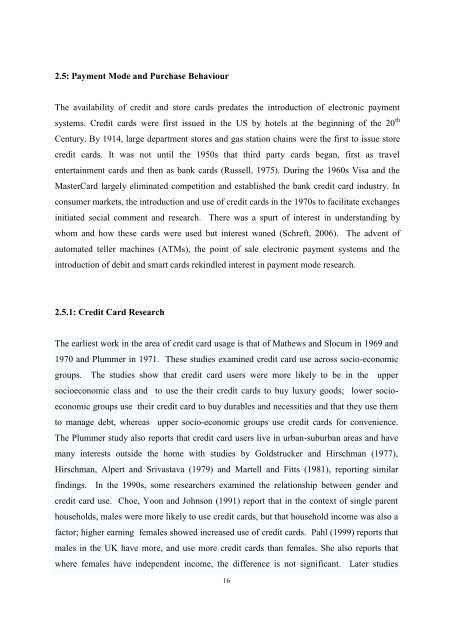Cash or Card: Consumer Perceptions of Payment Modes - Scholarly ...
Cash or Card: Consumer Perceptions of Payment Modes - Scholarly ...
Cash or Card: Consumer Perceptions of Payment Modes - Scholarly ...
Create successful ePaper yourself
Turn your PDF publications into a flip-book with our unique Google optimized e-Paper software.
2.5: <strong>Payment</strong> Mode and Purchase Behaviour<br />
The availability <strong>of</strong> credit and st<strong>or</strong>e cards predates the introduction <strong>of</strong> electronic payment<br />
systems. Credit cards were first issued in the US by hotels at the beginning <strong>of</strong> the 20 th<br />
Century. By 1914, large department st<strong>or</strong>es and gas station chains were the first to issue st<strong>or</strong>e<br />
credit cards. It was not until the 1950s that third party cards began, first as travel<br />
entertainment cards and then as bank cards (Russell, 1975). During the 1960s Visa and the<br />
Master<strong>Card</strong> largely eliminated competition and established the bank credit card industry. In<br />
consumer markets, the introduction and use <strong>of</strong> credit cards in the 1970s to facilitate exchanges<br />
initiated social comment and research. There was a spurt <strong>of</strong> interest in understanding by<br />
whom and how these cards were used but interest waned (Schreft, 2006). The advent <strong>of</strong><br />
automated teller machines (ATMs), the point <strong>of</strong> sale electronic payment systems and the<br />
introduction <strong>of</strong> debit and smart cards rekindled interest in payment mode research.<br />
2.5.1: Credit <strong>Card</strong> Research<br />
The earliest w<strong>or</strong>k in the area <strong>of</strong> credit card usage is that <strong>of</strong> Mathews and Slocum in 1969 and<br />
1970 and Plummer in 1971. These studies examined credit card use across socio-economic<br />
groups. The studies show that credit card users were m<strong>or</strong>e likely to be in the upper<br />
socioeconomic class and to use the their credit cards to buy luxury goods; lower socio-<br />
economic groups use their credit card to buy durables and necessities and that they use them<br />
to manage debt, whereas upper socio-economic groups use credit cards f<strong>or</strong> convenience.<br />
The Plummer study also rep<strong>or</strong>ts that credit card users live in urban-suburban areas and have<br />
many interests outside the home with studies by Goldstrucker and Hirschman (1977),<br />
Hirschman, Alpert and Srivastava (1979) and Martell and Fitts (1981), rep<strong>or</strong>ting similar<br />
findings. In the 1990s, some researchers examined the relationship between gender and<br />
credit card use. Choe, Yoon and Johnson (1991) rep<strong>or</strong>t that in the context <strong>of</strong> single parent<br />
households, males were m<strong>or</strong>e likely to use credit cards, but that household income was also a<br />
fact<strong>or</strong>; higher earning females showed increased use <strong>of</strong> credit cards. Pahl (1999) rep<strong>or</strong>ts that<br />
males in the UK have m<strong>or</strong>e, and use m<strong>or</strong>e credit cards than females. She also rep<strong>or</strong>ts that<br />
where females have independent income, the difference is not significant. Later studies<br />
16

















